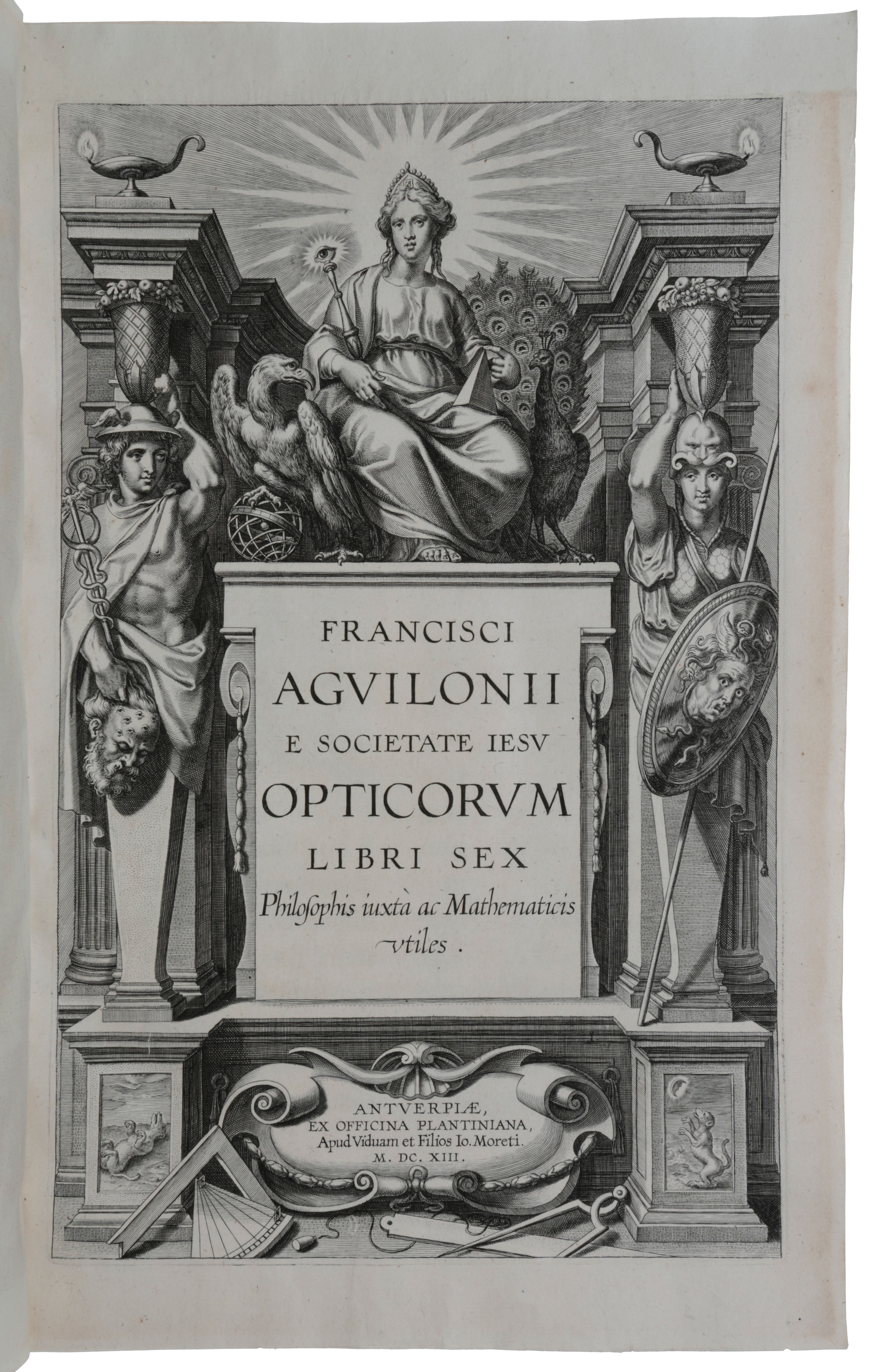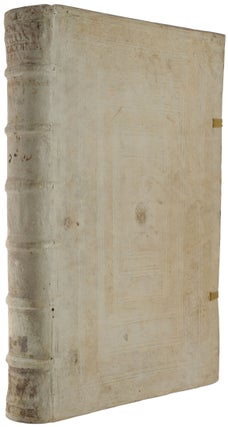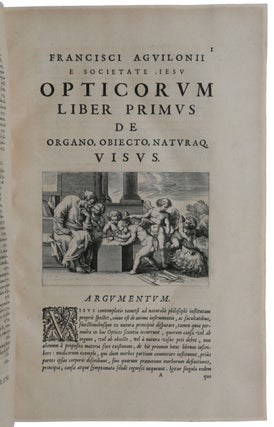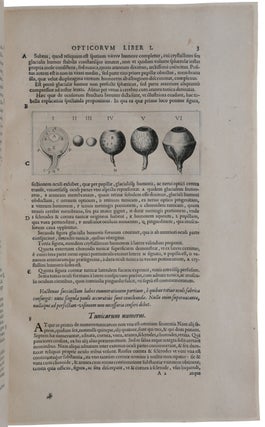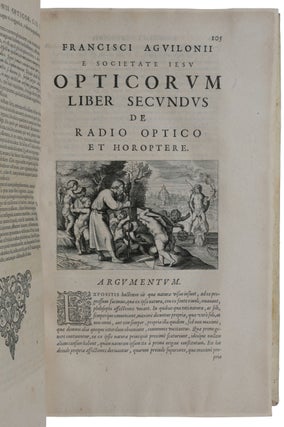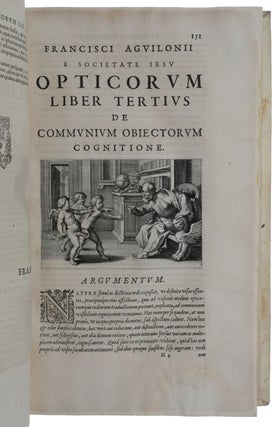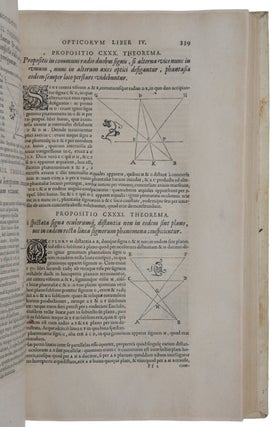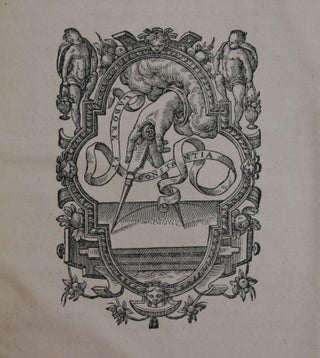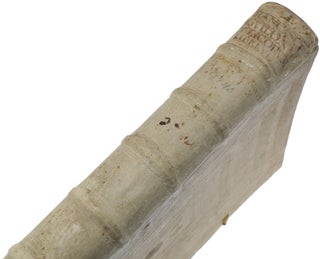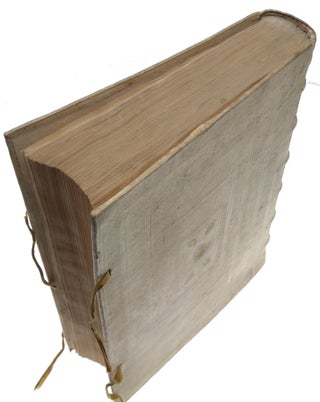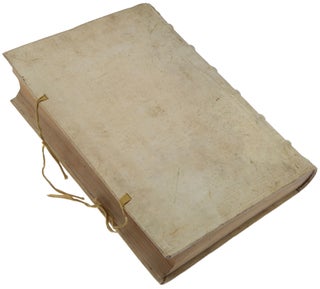Opticorum libri sex philosophis iuxta ac mathematicis utilis.
Antwerp: Plantin Press for the widow and sons of Jan Moretus, 1613. First edition, and a fine copy, of this great Jesuit treatise on optics, with engraved allegorical frontispiece and exquisite headpieces designed by Peter Paul Rubens. “A master treatise on optics that synthesized the works of Euclid, Ibn al-Haytham (Alhazen), Vitellio, Roger Bacon, Pena, Ramus (Pierre de la Ramée), Risner, and Kepler” (DSB). “A landmark of baroque book illustration, this is one of seven works known to have been illustrated by Rubens” (Becker).
“Aguilón was one of the first of a long line of distinguished Jesuit writers on optics. His treatise has acquired a great deal of attention because of its seven engravings after drawings by Rubens. It is not so well known that Aguilón’s color theory and his prescriptions for the mixing of colors were actually used by Rubens in his paintings” (Ashworth, in Jesuit science in the age of Galileo). “The color system of François d’Aguilón in 1613 is believed to be the oldest system to use red, yellow, and blue” (Burchett, A Bibliographic History of the study and use of color from Aristotle to Kandinsky, p. 19). “A remarkable collaboration between the scientific, printing and visual arts. Intended for
use in Jesuit schools, Aguilón’s work was primarily a synthesis of classical and modern writings on optics; however, it also contained the first discussion
of the stereographic process (which Aguilón named), one of the earliest presentations of the red-yellow-blue color system, an original theory of binocular vision and the first published description of Aguilón’s horopter” (Norman). “Amidst geometrical theorems stands out the discovery of the horopter as the area where objects are seen as single with both eyes. During the nineteenth century this concept developed into the contemporary science of vision” (Ziggelaar). “The sixth book, on orthographic, stereographic, and scenographic projections, remains important in the history of science. It accounts for a third of the treatise and was meant for the use of astronomers, cosmographers, architects, military leaders, navigators, painters, and engravers. It places particular emphasis on stereographic projection – a type of projection, used by Ptolemy, in which the portion of the sphere to.be represented is projected from the pole onto the plane of the equatorial circle. The balance of the treatise is of interest for the history of optics: description of the eye; controversies on the nature of light and its action; the application of mathematics to optics; the analysis of the concepts of distance, quantity, shape, place, position, continuity, discontinuity, movement, rest, transparency, opacity, shadow, light, resemblance, beauty, and deformity; and explanation of the various errors of perception. Book 5, in spite of an Aristotelian concept of light, studies the propagation of light, the limit of its action, the phenomena produced by the combinations of light sources, and the production of shadows. Aguilón proposes an experimental apparatus, drawn by Rubens, that made it possible to study the variations of intensity according to variations in distance and to compare lights of different intensities. This attempt … resulted in Bouguer’s photometer” (DSB). Fine copies such as ours in untouched contemporary bindings are rare on the market. Born in Brussels, the son of a secretary to Philip II, Aguilón (1567-1617) became a Jesuit in 1586. In 1598 he moved to Antwerp, where in 1611 he started a Jesuit school of mathematics, fulfilling a dream of Christopher Clavius; in 1616, he was joined there by Grégoire de Saint-Vincent. The notable geometers educated at this school included Jean-Charles de la Faille, André Tacquet, and Theodorus Moretus. Regarded by the Society of Jesus as their greatest authority in the science of optics, Aguilón was associated with several members of Galileo’s earliest audience. He was in particularly close touch with Christoph Scheiner, a Jesuit professor of mathematics in Ingolstadt then engaged, under the name of ‘Apelles’, in the sunspot controversy with Galileo. In Book V (p. 421), which was partly devoted to a discussion of the lunar globe, Aguilón mentioned the sunspot observations and Scheiner’s pseudonym. Written in 1610-1611, the manuscript of Opticorum libri sex received the approval of the censor on 9 December 1611 and that of the provincial superior on 15 January 1612; the book was issued by the Plantin Press late in 1613. After the death of the influential publisher Christopher Plantin in 1589, the business was continued by his son-in-law Jan Moretus; after his death in 1610, the widow Martina Plantin and the sons Balthasar and Jan took over. The family Moretus was on good terms with the Jesuits; as early as 1593, the provincial superior had decided that books should be published exclusively through Moretus. The Opticorum libri sex was dedicated to the Spanish commander of the fortress of Antwerp, Iñigo de Borja (ca. 1575-1622). Iñigo was a great grandson of Saint Francisco de Borja who had been Duke of Gandia in Spain before he became a Jesuit. After the death of his wife he entered the Society of Jesus publicly in 1551 and in 1565 he became the third general superior of the Society. In his preface Aguilón states that this is the first of three books on optics, intended to be followed by a second on catoptrics and a third on dioptrics, but his death prevented the completion of the last two parts; only a few manuscript sections of the catoptrics were produced. The Opticorum libri sex is famous for its frontispiece and six headpieces which begin each book, all designed by Rubens (1577-1640) (although Aguilón never mentions Rubens by name). At the time of publication, Aguilón was Rector of the Jesuit Maison Professe at Antwerp and Rubens had become a member of the Grand Sodality of the Enunciation at the Maison. The frontispiece, by Cornelius Galle from a drawing by Rubens, “is full of symbols of light. A lady (the goddess Juno or a personification of the optics) is seated between a peacock and an eagle holding an armillary sphere; Mercury and Minerva stand by, Mercury holding in his hand an Argus' head full of eyes, Minerva a shield reflecting the head of Medusa. Below them are two animals, resembling dogs, one lies on its back, under a new moon, while the other one stands on its hind legs looking at a waning moon; between them are a few measuring instruments. The dogs illustrate what Aguilón mentions in the Preface to the reader, that cynocephali, legendary animals, are blind during the dark of the moon and greet the new moon with their front legs extended upwards. The scepter, the peacock and the Argus-head refer clearly to the organ of vision, the eye; the eagle, in Latin aquila, may hint at the name of the author, Aguilonius in Latin” (Ziggelaar). “The engraved title page on its own would suggest no more than an illustrator’s job well and professionally done. However, the vignettes which Rubens provided for the individual title pages of each of the six books show such a complex and knowing relationship to the text as to leave no doubt that Ruben’s intellectual involvement was considerable. The vignettes range from compositions which exhibit clever if general relationship to the book in question to those which make quite specific references to the arguments in the text” (Kemp, pp. 101-103). Aguilón’s work is divided into six books. In modern science, optics means the physics of light, but until about the Renaissance optics was the science of vision. Aguilón therefore began by asking how light is perceived – how do we see? In Book I, ‘On the Organ, Object, and Nature of Sight,’ Aguilón presents the ocular anatomy of Vesalius: the seat of vision is the crystalline humor, which receives species of shape and colour which are emitted by an object before entering the eye. Light and colour are presented as the proper objects of vision, and here Aguilón introduces his modification of Aristotle’s colour theory and presents a colour diagram showing colour relationships. The headpiece “illustrates the dissection of the conveniently large eye of a Cyclops, in keeping with Aguilón’s insistence on accurate knowledge of the eye’s structure” (Kemp. p. 103). In Book II, ‘On the Visual Ray and the Horopter,’ Aguilón introduces the cones of vision, one for each eye, discusses binocular vision and, famously, describes the ‘horopter.’ “For Aguilon, it is obvious that binocular vision is more effective than monocular … Aguilon states that only one point can be seen distinctly with two eyes, that is to say the point in which the axes of each eye converge to. This point within the visual field defines a plane perpendicular to the axes, which is coined horopter. Aguilón observed that within this plane, objects were seen singly, and that outside of it they were seen doubly” (Gallay). The headpiece “displays a range of surveying instruments in action, including a staff for the optical measurement of the Colossus of Rhodes. These complement Aguilón’s discussion of Euclidean angles as the foundation of visual judgment” (ibid.). Book III, ‘On the Cognition of Common Objects,’ covers aspects of perception that had long been part of Perspectiva: distance, quantity, shape, location, situation, continuity and discreteness, and motion. The headpiece “represents a ‘humorous experiment’ described in the text, in which the author points out how difficult it is to reach out with certainty to touch a small object using one eye alone” (ibid.). In Book IV, ‘On Misleading Appearances,’ Aguilón considers, using the idea of the horopter, the perceptual mistakes that can be made: distance, size, situation, shapes (circle, squares, spheres, cylinders, and cones), location, number, motion, and light and shadow. “The illustration shows how an object is seen in two different places relative to the background when viewed by each eye in succession. Parallax was also a key concept in the astronomical measurement of distances” (ibid.). The first part of Book V, ‘On Light and Shadow,’ deals with the nature of light, its propagation, and diminution in brightness with increasing distance from the source. This book “is the most interesting experimentally, and [the headpiece] depicts one of two key set-ups devised by Aguilón to show that the relationship between the strengths of light sources and their diminution over distance does not simply stand in inverse ratio … The result of this experiment goes against common expectation and, I suspect, would have perturbed Leonardo, who believed that the uniformly pyramidal law applied in all such cases of the diminution of the powers of nature. The law at work here, as we now know, is the inverse square law, which is so widely used in astronomical calculations of distances” (ibid.). This book also treats illumination and shadows, ending with a section on a pre-Keplerian consideration of the camera obscura. The final Book VI, ‘On Projections,’ is easily the longest, encompassing nearly one-third of the entire work. It presents an elaborate, geometric consideration of projection, with particular emphasis on utility for architects, sculptors, scenographers, and painters. The material in all six books has a Euclidean form, with definitions, propositions, proofs and conclusions. The headpiece “shows a rough-and-ready means of projecting a celestial sphere onto a plane surface. Aguilón acknowledged Commandino’s works on orthographic and stereographic projection and looked towards Guidobaldo for the related science of cast shadows … He provides a clear outline of the basic points in Guidobaldo’s treatise, including neatly designed diagrams of the convergence of parallel lines perpendicular to the picture plane and the construction of a circle in projection using the theorem of the punctum concursus” (ibid.). “Aguilon dealt with both parallel and central projections. He remarked that a parallel projection can be considered as a central projection having an eye located at an infinite distance (p. 503). He liked to play with the variety of parallel projections, and showed how it is possible to have a cube projected as a regular hexagon. He gave several examples of applications of projections, of which perspective was one, and the construction of sundials another” (Andersen, p. 403). “We may assume that Rubens consented to design six large vignettes for the opening page of each book of Aguilón’s Optics not only as a favour to his friend Balthasar Moretus, soon to be sole publisher of the Plantinian Press, but because the subject itself was of interest to him. The artist is known to have occupied himself with theoretical problems, but not much of these studies have been preserved. The Aguilón vignettes, in fact, are delightful as designs (and ably engraved by Theodoor Galle) and also render complex scientific actions and experiments with utmost clarity. It stands to reason that for some time Rubens and Aguilón must have been in close contact; and just as the first great manual on optics must have been of considerable interest to Rubens, so the learned Jesuit surely was aware of the intellectual capacity and outstanding artistic talent of the painter, ten years his junior” (Held, p. 257). In addition to notebooks on optical and other matters, Rubens is known to have composed a separate essay ‘on the subject of colours.’ “The engraved vignettes, by their black and white nature, are not well suited to illustrate colour theories, but the conspicuous peacock on the title page stands as an appropriate allusion to the author’s promised discussion of colours. There had been little advance in colour theory since Aristotle, until Aguilon suggested that, in addition to white (albus) and black (niger), the most important elements of Aristotle’s colour theory, there are three other primary colours: yellow (flavus), red (rubeus) and blue (caeruleus). Aguilón “provides what may be called the definitive version of the colour scales, based upon ‘five species of simple colour with three composites.’ Between the inevitable poles of white and black come yellow, red and blue, which in turn form the three ‘composite’ colours: orange (yellow and red); purple (red and blue); and green (yellow and blue). In the published book these ‘simple’ and ‘composite’ colours are laid out in a figure, which resembles a proportional demonstration of musical harmonics. Although Aguilón stresses that he is talking about ‘visible qualities’ rather than the painter’s material colours, the compounds formed by the three intermediate primaries correspond precisely to pigment mixtures rather than coloured lights. In establishing his ‘simple’ and ‘composite’ colours, Aguilón may well have been drawing upon his friend’s experience as a painter, and we can see that his system of mixtures is identical to one which became accepted as the painter’s standard … “We have already seen that Rubens’s vignette designs for Aguilón exhibited a genuine understanding of the corresponding text, and it cannot be doubted that he was more than adequately equipped to understand the sections on colour. Two works of art – one drawing and one painting – appear to be so closely linked to Aguilón’s colour theories as to suggest that the philosopher’s ideas found a receptive audience in the painter. “The link with the drawing, a study of trees reflected in water, is the more certain, since Rubens has provided us with an Aguilónian annotation. He notes that ‘the reflection of the trees in the water is darker and more perfect in the water than in the trees themselves.’ There is no problem interpreting the term ‘more perfect’, since it is that used by Aguilón to denote shadow which is more dense or ‘penumbral.’ We can also turn to the philosopher for an explanation of the enhanced darkness of certain shadows. Aguilón explained that: ‘the closer the shadow is to an opaque body, the darker it is, and it appears to be even darker than the object itself … Since the shadow is diminished light compared to the stronger light which surrounds it, (according to the 12th Definition of this book), the brighter the surrounding light the more it dulls the observer’s sight and the more fully it will darken the area of lesser luminosity. Thus the shadow appears darker than the object itself’ [p. 427] … “The painting which most clearly declares its relationship to the Opticorum libri sex is the Juno and Argus in Cologne, almost certainly painted at the time of his work on the illustrations. Its subject matter is clearly associated with the title-page, centering as it does upon the Ovidian myth of Juno sprinkling the two hundred eyes of Argus on the peacock’s tail. To underline the visual implications of the subject, Rubens has included Iris, who was not part of Ovid’s story but who is an appropriate companion for the goddess of weather. He has provided her with a rainbow that carefully exhibits the red, yellow and blue ‘simple’ colours, interspersed with the orange, green and violet ‘composites’ [not, of course, the order of the colours in an actual rainbow] … “Aguilón proposed three kinds of colour mixture: compositio realis, in which materials are mixed to produce colours, as when the ‘composite colour’ green is made from ‘a mixture of yellow and blue’; compositio intentionalis, in which colours are combined within a diaphanous medium, as when painting ‘something beneath water’; and compositio notionalis, in which ‘patches’ of colour, so small as to ‘escape the eye,’ converge as ‘sensory impressions in the eye so that for each combination of the colours a uniform colour is received.’ This third category refers to what we would call optical mixture. It is an effect exploited brilliantly and extensively by Rubens, particularly for flesh tones. The body of Argus, for example, is composed from a remarkable mélange of pink, pale yellow, grey and green, applied in separate touches and only partially blended” (Kemp, pp. 275-276). Albert et al. 27; Becker 5; BL STC Low Countries 1601-1621, A36; Corpus Rubenianum XXI, 10-16; De Backer-Sommervogel I, col. 90, no. 1; Hofer 116; Honeyman 43; Jesuit science 8; NLM/Krivatsy 92; Norman 25; Simoni A36; Sotheran I 43-44. Andersen, The Geometry of an Art, 2007. Gallay, The Quest for Perfect Vision. Dissertation,
University of Cambridge, 2013. Held, ‘Rubens and Aguilonus: New points of contact, Art Bulletin (1979), pp. 257-64. Kemp, The Science of Art, 1990. Ziggelaar, ‘François De Aguilón’s Opticorum Libri Sex – First Description of the Horopter, the Area of Single Vision, in 1613,’ Strabismus19 (2011), p. 166. For a detailed analysis of the work, see: Ziggelaar, François de Aguilón S.J. (1567-1617), Scientist and Architect, 1983.
Folio (355 x 227 mm), pp. [xlviii, including half-title and engraved title], 684, [44], with six engraved headpieces, one other engraving and numerous woodcut illustrations in text (light damp-stain in lower blank margin of about 50 pages in the middle of the volume). Contemporary blind-stamped vellum with two ties, handwritten label on spine. A fine and very attractive copy, virtually free of the browning that usually affects this work.
Item #4987
Price: $22,500.00

